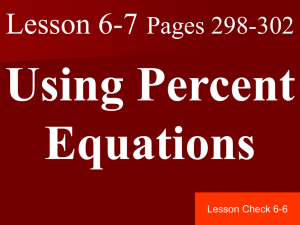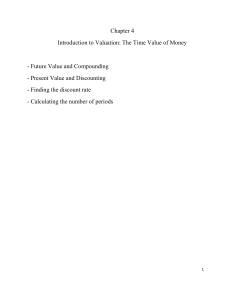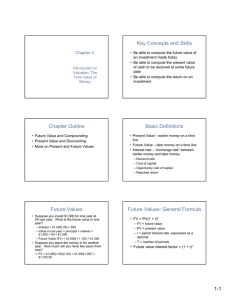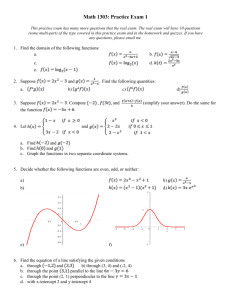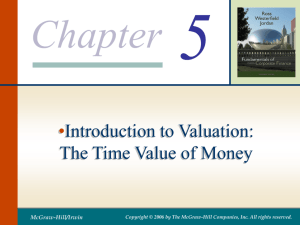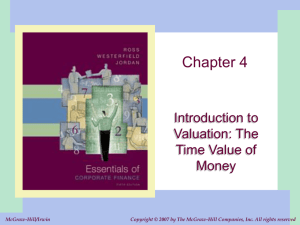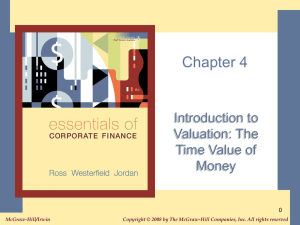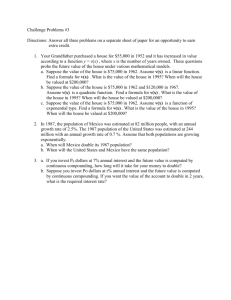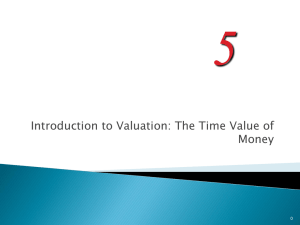CH. 3
advertisement
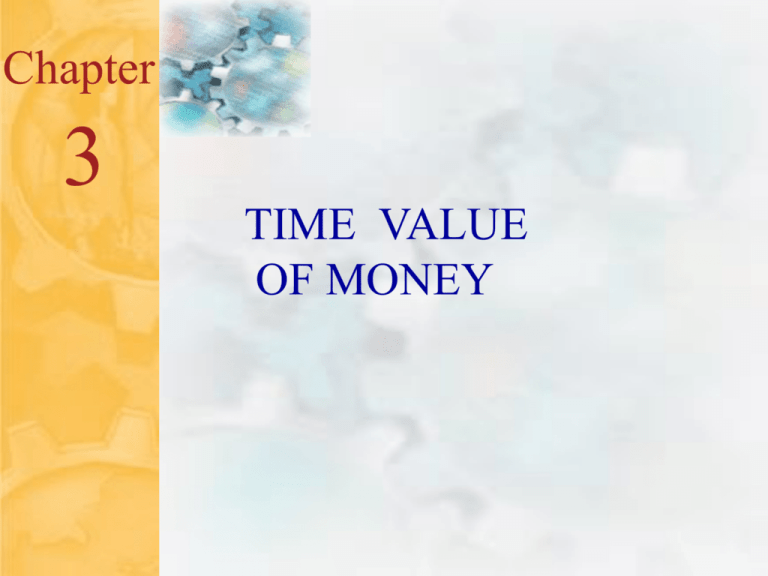
4.0 Chapter 3 TIME VALUE OF MONEY 4.1 Key Concepts and Skills Understand valuation principle and how it can be used to identify decisions which increase firm value Be able to compute the future value of an investment made today Be able to compute the present value of cash to be received at some future date Be able to compute the return on an investment 4.2 Chapter Outline Valuation Principle Future Value and Compounding Present Value and Discounting More on Present and Future Values 4.3 Cost/Benefit & Decision Making Cost/Benefit PV of Benefits vs. PV of Costs Net Present Value (NPV) Decision Rule 4.4 Basic Definitions Value – earlier money on a time line Future Value – later money on a time line Interest rate – “exchange rate” between earlier money and later money Present Discount rate Cost of capital Opportunity cost of capital Growth Rate Required return 4.5 Future Values Suppose you invest $100 for one year at 10% per year. What is the future value in one year? Interest = $100(.10) = $10 Value in one year = principal + interest = $100 + $10 = $110 Future Value (FV) = $100(1 + .10) = $110 Suppose you leave the money in for another year. How much will you have two years from now? FV = $100(1.10)(1.10) = $100(1.10)2 = $121 4.6 4.7 Future Values: General Formula value interest factor = (1 + r)t FV = PV(1 + r)t Future FV = future value PV = present value r = period interest rate, expressed as decimal = i T = number of periods = N value interest factor = (1 + r)t FV = PV(1 + i)n Future 4.8 Effects of Compounding Simple interest Compound interest Consider the previous example FV with simple interest = 100 + 10 + 10 = $120 FV with compound interest = $121 The extra $1.00 comes from the interest of .10($10) = $1.00 earned on 1st interest payment 4.9 4.10 Calculator Keys FINANCIAL CALCULATORS FV = future value PV = present value I/Y = period interest rate P/Y must equal 1 for the I/Y to be the period rate Interest is entered as a percent, not a decimal N = number of periods Remember to clear the registers (SHIFT -CLR ALL) after each problem Other calculators are similar in format 4.11 Future Values – Example 2 Suppose you invest the $100 from the previous example for 5 years. How much would you have? 5N 10% I/Y <100> PV FV = ? = The effect of compounding is small for a small number of periods, but increases as the number of periods increases. 4.12 Future Values – Example 3 Suppose you had a relative deposit $10 at 5.5% interest 200 years ago. How much would the investment be worth today? 200 N 5.5 I/Y - 10 PV FV = ? = What is the effect of compounding? Simple interest = 10 + 200(10)(.055) = $120 Compounding added $447,069.84 to the value of the investment 4.13 Future Value as a General Growth Formula Suppose your company expects to increase unit sales of widgets by 15% per year for the next 5 years. If you currently sell 3 million widgets in one year, how many widgets do you expect to sell in 5 years? 5N 15 I/Y 3,000,000 PV FV = ? units (remember the sign convention) 4.14 Non-Annual Compounding $5 today; 10% / yr rate; 3 years; FV=? Annual Semi Quarterly 4.15 Quick Quiz – Part 1 What is the difference between simple interest and compound interest? Suppose you have $500 to invest and you believe that you can earn 8% per year over the next 15 years. How much would you have at the end of 15 years using compound interest? How much would you have using simple interest? 4.16 Present Values How much do I have to invest today to have some amount in the future? FV = PV(1 + r)t Rearrange to solve for PV = FV / (1 + r)t When we talk about discounting, we mean finding the present value of some future amount. When we talk about the “value” of something, we are talking about the present value unless we specifically indicate that we want the future value. Present Value – One Period Example 4.17 Suppose you need $10,000 in one year for the down payment on a new car. If you can earn 7% annually, how much do you need to invest today? PV = 10,000 / (1.07)1 = 9345.79 Calculator 1N 7 I/Y 10,000 FV PV = ? = 4.18 Present Values – Example 2 You want to begin saving for you daughter’s college education and you estimate that she will need $150,000 in 17 years. If you feel confident that you can earn 8% per year, how much do you need to invest today? N= I/Y = FV = PV = ? = (remember the sign convention) 4.19 Present Values – Example 3 Your parents set up a trust fund for you 10 years ago that is now worth $19,671.51. If the fund earned 7% per year, how much did your parents invest? N= I/Y = FV = PV = ? = Present Value – Important Relationship I 4.20 a given interest rate – the longer the time period, the lower the present value For What is the present value of $500 to be received in 5 years? 10 years? The discount rate is 10% 5 years: N = ; I/Y = ; FV = PV = ? = 10 years: N = ; I/Y = ; FV = PV = ? Present Value – Important Relationship II 4.21 a given time period – the higher the interest rate, the smaller the present value For What is the present value of $500 received in 5 years if the interest rate is 10%? 15%? Rate = %: N = ; I/Y = ; FV = PV = ? = Rate = 15%; N = 5; I/Y = 15; FV = 500 PV = ? 4.22 Quick Quiz – Part 2 What is the relationship between present value and future value? Suppose you need $15,000 in 3 years. If you can earn 6% annually, how much do you need to invest today? If you could invest the money at 8%, would you have to invest more or less than at 6%? How much? 4.23 The Basic PV Equation - Refresher = FV / (1 + r)t There are four parts to this equation PV PV, FV, r and t If we know any three, we can solve for the fourth If you are using a financial calculator, be sure and remember the sign convention or you will receive an error when solving for r or t 4.24 Discount Rate Often we will want to know what the implied interest rate is in an investment Rearrange the basic PV equation and solve for r FV = PV(1 + r)t r = (FV / PV)1/t – 1 If you are using formulas, you will want to make use of both the yx and the 1/x keys 4.25 Discount Rate – Example 1 You are looking at an investment that will pay $1200 in 5 years if you invest $1000 today. What is the implied rate of interest? r = (1200 / 1000)1/5 – 1 = .03714 = 3.714% Calculator – the sign convention matters!!! N=5 PV = -1000 (you pay 1000 today) FV = 1200 (you receive 1200 in 5 years) I/Y = ? = 4.26 Discount Rate – Example 2 Suppose you are offered an investment that will allow you to double your money in 6 years. You have $10,000 to invest. What is the implied rate of interest? N= PV = FV = I/Y = ? = 4.27 Discount Rate – Example 3 Suppose you have a 1-year old son and you want to provide $75,000 in 17 years towards his college education. You currently have $5000 to invest. What interest rate must you earn to have the $75,000 when you need it? N= PV = FV = I/Y = ? = 4.28 Quick Quiz – Part 3 What are some situations where you might want to compute the implied interest rate? Suppose you are offered the following investment choices: You can invest $500 today and receive $600 in 5 years. The investment is considered low risk. You can invest the $500 in a bank account paying 4%. What is the implied interest rate for the first choice and which investment should you choose? 4.29 Finding the Number of Periods Start with basic equation and solve for t (remember you logs) FV = PV(1 + r)t t = ln(FV / PV) / ln(1 + r) You can use the financial keys on the calculator as well, just remember the sign convention. 4.30 Number of Periods – Example 1 You want to purchase a new car and you are willing to pay $20,000. If you can invest at 10% per year and you currently have $15,000, how long will it be before you have enough money to pay cash for the car? I/Y = PV = FV = N=?= 4.31 Number of Periods – Example 2 Suppose you want to buy a new house. You currently have $15,000 and you figure you need to have a 10% down payment plus an additional 5% in closing costs. If the type of house you want costs about $150,000 and you can earn 7.5% per year, how long will it be before you have enough money for the down payment and closing costs? Number of Periods – Example 2 Continued How much do you need to have in the future? Down payment = Closing costs = Total needed = Compute the number of periods 4.32 PV = FV = I/Y = N=?= Using the formula t = ln(21,750 / 15,000) / ln(1.075) = 5.14 years = 15,000 = 6,750 = 21,750 4.33 Table 3.4 I. Symbols PV = Present value, what future cash flows are worth today FVt = Future value, what cash flows are worht in the future r = Interest rate, rate of return, or discount rate per period –typically, but not always one year t = Number of periods–typically, but not always, the number of years C = Cash amount II. Future value of C invested at r percent per period for t periods FVt = C X (1 + r)t The term (1 + r)t is called the future value factor. III. Present value of C to be received in t periods at r percent per period PV = C/(1 + r)t The term 1/(1 + r)t is called the present value factor. IV. The basic present value equation giving the relationship between present and future value is PV = FVt /(1 + r)t 4.34 Quick Quiz – Part 4 When might you want to compute the number of periods? Suppose you want to buy some new furniture for your family room. You currently have $500 and the furniture you want costs $600. If you can earn 6%, how long will you have to wait if you don’t add any additional money?

